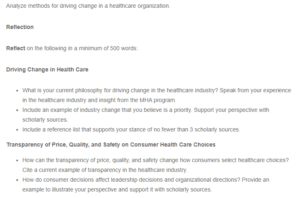Analyzing Methods for Driving Change in a Healthcare Organization
The Changing Healthcare
Driving change in the healthcare industry is an ongoing challenge that requires a multifaceted approach. One key strategy for driving change is engaging stakeholders across all healthcare organization levels, including patients, healthcare providers, administrators, policymakers, and the wider community. Collaboration and communication are essential to creating a shared vision for change, identifying goals, and implementing solutions.
Effective leadership is also critical to driving change in the healthcare industry. Leaders must be proactive, innovative, and open to new ideas and perspectives.
Current Philosophy for Driving Change in the Healthcare Industry
My philosophy for driving change in the healthcare industry is to prioritize patient-centred care. Prioritizing patient-centred care places the patient at the centre of all decision-making and prioritizes their needs and preferences (Siegal et al., 2023). Healthcare organizations can improve patient outcomes and increase patient satisfaction by focusing on patient-centred care.
Example of an Industry Change That Is a Priority
One industry change that is a priority in healthcare is the shift toward value-based care. Value-based care is a philosophy that focuses on improving patient outcomes while reducing costs (Theunissen et al., 2023). It emphasizes the importance of delivering high-quality, evidence-based care tailored to each patient’s individual needs. According to the Centres for Medicare and Medicaid Services (CMS), the shift towards value-based care is a key priority for the healthcare industry. The CMS has established several programs and initiatives to support this shift, including the Medicare Access and CHIP Reauthorization Act of 2015 (MACRA) and the Quality Payment Program (QPP) (Chen et al., 2023). These programs incentivize healthcare providers to focus on delivering high-quality care and improving patient outcomes rather than providing more services.
The Effect of Price, Quality, and Safety Transparency on Consumers’ Healthcare Choices
Price transparency can help consumers understand the cost of different healthcare services and make more cost-effective decisions. For example, if a consumer needs to undergo a medical procedure, they can compare prices across various healthcare providers and select the best value for their money. Quality transparency can help consumers evaluate the quality of healthcare services and choose providers that offer the best care. By accessing information about healthcare provider ratings, patient satisfaction scores, and other quality metrics, consumers can decide which providers will likely provide the best care for their needs.
Safety transparency can help consumers evaluate the safety of healthcare services and select providers that prioritize patient safety. By accessing information about healthcare provider safety ratings, infection rates, and other safety metrics, consumers can make informed decisions about which providers will likely offer the safest care. A current example of transparency in the healthcare industry is the Hospital Compare website maintained by the Centres for Medicare and Medicaid Services (CMS). The Hospital Compare website allows consumers to compare the quality and safety of hospitals across the United States. Consumers can access information about hospital ratings, patient satisfaction scores, and other quality and safety metrics to make informed decisions about their care.
How Consumer Decisions Affect Leadership Decisions and Organizational Directions
Consumer decisions can significantly impact leadership decisions and organizational directions in the healthcare industry. When consumers make choices about their healthcare, they are essentially indicating their preferences and priorities, which can inform the decisions made by healthcare leaders and organizations. One example of how consumer decisions can affect leadership decisions and organizational directions is in the area of telemedicine. According to Cannavacciuolo et al. (2022), as more consumers have embraced telemedicine as a convenient and accessible way to receive healthcare services, healthcare leaders and organizations have adjusted their strategies and offerings accordingly.
References
Cannavacciuolo, L., Capaldo, G., & Ponsiglione, C. (2022). Digital innovation and organizational changes in the healthcare sector: Multiple case studies of telemedicine project implementation. Technovation, 102550. https://doi.org/10.1016/j.technovation.2022.102550
Chen, D. Q., Parvataneni, H. K., Miley, E. N., Deen, J. T., Pulido, L., Prieto, H., & Gray, C. F. (2023). Lessons Learned from The Comprehensive Care for Joint Replacement (CJR) Model at an Academic Tertiary Center: the Good, the Bad, and the Ugly. The Journal of Arthroplasty. https://doi.org/10.1016/j.arth.2023.02.014
Siegal, R., Nance, A., Johnson, A., & Case, A. (2023). “Just because I have a medical degree does not mean I have the answers”: Using CBPR to enhance patient-centred care within a primary care setting. American Journal of Community Psychology. https://doi.org/10.1002/ajcp.12677
Theunissen, L., Cremers, H.-P., Dekker, L., Janssen, H., Burg, M., Huijbers, E., Voermans, P., Kemps, H., & van Veghel, D. (2023). Implementing Value-Based Health Care Principles in the Full Cycle of Care: The Pragmatic Evolution of the Netherlands Heart Network. Circulation: Cardiovascular Quality and Outcomes. https://doi.org/10.1161/circoutcomes.122.009054
ORDER A PLAGIARISM-FREE PAPER HERE
We’ll write everything from scratch
Question

Analyzing Methods for Driving Change in a Healthcare Organization
Analyze methods for driving change in a healthcare organization.
Reflection
Reflect on the following in a minimum of 500 words:
Driving Change in Health Care
- What is your current philosophy for driving change in the healthcare industry? Speak from your experience in the healthcare industry and insight from the MHA program.
- Include an example of industry change that you believe is a priority. Support your perspective with scholarly sources.
- Include a reference list that supports your stance of no fewer than 3 scholarly sources.
Transparency of Price, Quality, and Safety on Consumer Health Care Choices
- How can the transparency of price, quality, and safety change how consumers select healthcare choices? Cite a current example of transparency in the healthcare industry.
- How do consumer decisions affect leadership decisions and organizational directions? Provide an example to illustrate your perspective and support it with scholarly sources.

